Sotheby’s new generative art program will now record all of its sales on the Ethereum network. This marks huge progress in the blockchain art industry. Here’s everything you need to know.
TL;DR
- Sotheby’s launches the on-chain Gen Art Program, recording NFT sales on the Ethereum network. It features 500 unique generative pieces by Vera Molnár.
- The Gen Art Program marks Sotheby’s first digital art auctions held entirely on the blockchain. It follows their shift to a fully on-chain metaverse, with all sales made in ETH.
- The program introduces a Dutch auction model, starting with high prices and gradually reducing. Therefore, this signals a shift in focus from technology to the artistic expression of generative art.

On-Chain Art Program by Sotheby’s
Sotheby’s is moving to NFTs with its new on-chain Gen Art Program, and sales will be recorded on the Ethereum network. The program, powered by Art Blocks, will feature a series of 500 unique generative artworks by algorithmic artmaker Vera Molnár. Thus, showing the integration of letters as abstract forms and disorders.
Michael Bouhanna, Sotheby’s head of digital art and NFTs, revealed that all Gen Art Program sales will be made in ETH. Therefore, marking the first digital art auctions held on the blockchain. Moreover, this move follows their transition to a fully on-chain metaverse in May. This shows their commitment to exploring more fully on-chain sale options.
In addition, the initial sale will be a Dutch auction, starting with high prices and slowly reducing, with the first offer winning the lot. Sotheby’s sees this as bringing new psychologies into the auction process as they set the ceiling price for works in the Molnár sale at 20 ETH.
What’s more, the success of Art Blocks’ partnerships and Sotheby’s NFT sales has paved the way for the launch of the Gen Art Program. By putting a focus on long-form generative art from a central algorithm, this aims to work directly with leading artists for new sales.
The growing respect for generative art in the art world has led to a shift in focus from the technology behind it to the art itself. Blockchain technology is taking a back seat as creators and fans value the unique art expressions created by algorithms.
Vera Molnár views this as the result of years of exploring how systems and computers can produce art. Finally, it provides a new way to create unique forms of art through the controlled randomness of machine programming. Thus, further showing the essence of the algorithm.
All investment/financial opinions expressed by NFTevening.com are not recommendations.
This article is educational material.
As always, make your own research prior to making any kind of investment.








